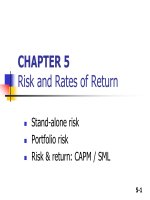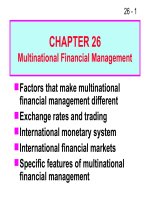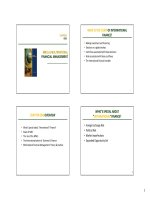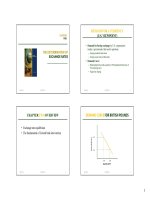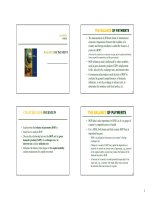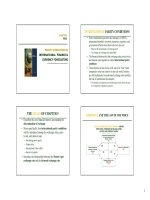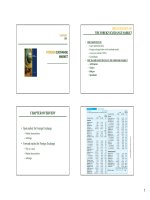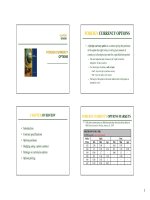Lecture Multinational financial management: Lecture 5 - Dr. Umara Noreen
Bạn đang xem bản rút gọn của tài liệu. Xem và tải ngay bản đầy đủ của tài liệu tại đây (231.02 KB, 29 trang )
Lecture
5
International Financial Markets
Chapter Objectives
To describe the background and
corporate use of the following
international financial markets:
foreign exchange market,
international money market,
international credit market,
international bond market, and
international stock markets.
Motives for Using
International Financial Markets
• The markets for real or financial assets
are prevented from full integration by
barriers like tax differentials, tariffs,
quotas, labor immobility, communication
costs, cultural and financial reporting
differences.
• Yet, such market imperfections also
create unique opportunities for specific
geographic markets, helping these
markets attract foreign creditors and
investors.
Motives for Using
International Financial Markets
• Investors invest in foreign markets:
– to take advantage of favorable economic
conditions;
– when they expect foreign currencies to
appreciate against their own; and
– to reap the benefits of international
diversification.
Motives for Using
International Financial Markets
• Creditors provide credit in foreign
markets:
– to capitalize on higher foreign interest rates;
– when they expect foreign currencies to
appreciate against their own; and
– to reap the benefits of diversification.
• Borrowers borrow in foreign markets:
– to capitalize on lower foreign interest rates;
– and when they expect foreign currencies to
depreciate against their own.
Foreign Exchange
Market
• The foreign exchange market allows
currencies to be exchanged in order to
facilitate international trade or financial
transactions.
• The system for exchanging foreign
currencies has evolved from the gold
standard, to agreements on fixed
exchange rates, to a floating rate system.
Foreign Exchange
Transactions
• The market for immediate exchange is
known as the spot market.
• Trading between banks occurs in the
interbank market. Within this market,
brokers sometimes act as
intermediaries.
Foreign Exchange
Transactions
• The forward market enables an MNC to
lock in the exchange rate at which it will
buy or sell a certain quantity of currency
on a specified future date.
• Customers in need of foreign exchange
are concerned with quote
competitiveness, special banking
relationship, speed of execution, advice
about current market conditions, and
forecasting advice.
Foreign Exchange
Transactions
• Banks provide foreign exchange services
for a fee: a bank’s bid (buy) quote for a
foreign currency will be less than its ask
(sell) quote.
ask rate – bid rate
bid/ask spread =
ask rate
Example Suppose bid price for £ = $1.52,
ask price = $1.60.
(1.60 – 1.52) = .05 or 5%
Spread =
1.60
Foreign Exchange
Transactions
• The spread on currency quotations is
positively influenced by order costs,
inventory costs, and currency risk,
and
negatively influenced by competition, and
volume.
• The markets for heavily traded currencies
like the €, £, and ¥ are very liquid.
Interpreting
Foreign Exchange Quotations
• The exchange rate quotations
published in newspapers normally
reflect the ask prices for large
transactions.
• Direct quotations represent the value of
a foreign currency in dollars, while
indirect quotations represent the
number of units of a foreign currency
per dollar.
Interpreting
Foreign Exchange Quotations
• A cross exchange rate reflects the
amount of one foreign currency per unit
of another foreign currency.
Example Direct quote:
$.009/¥
$1.50/£,
Indirect quote: .67£/$, 111.11¥/$
Value of £ in ¥ =
value of £ in $
= 166.67¥/£
value of ¥ in $
Currency Futures and Options
Market
• Currency futures contracts specify a
standard volume of a particular
currency to be exchanged on a specific
settlement date. They are sold on
exchanges, unlike forward contracts.
• Currency call (put) options give the right
to buy (sell) a specific currency at a
specific price (called the strike or
exercise price) within a specific period
of time.
International Money
Market
• Financial institutions in this market serve
MNCs by accepting deposits and offering
loans in a variety of currencies.
International Money
Market
• Both the European and Asian money
markets originated as markets involving
mostly dollar-denominated deposits.
• The Eurocurrency market (market for
Eurodollars) developed during the
1960s and 1970s, stimulated by
regulatory changes in the U.S. and the
growing importance of OPEC.
International Money
Market
• The growing standardization of global
banking regulations has contributed
towards the globalization of the
industry.
– The Single European Act opened up the
European banking industry and increased
its efficiency.
– The Basel Accord outlined risk-weighted
capital adequacy requirements for banks.
– The proposed Basel II Accord attempts to
account for operational risk.
International Credit Market
• MNCs sometimes obtain medium-term
funds through banks located in foreign
markets.
• Eurocredit loans refer to loans of one
year or longer extended by banks in
Europe to foreign MNCs or government
agencies.
• Floating rate loans, such as those based
on the LIBOR, are common, since bank
asset and liability maturities may not
International Credit Market
• Sometimes a single bank is unwilling or
unable to lend the amount needed by a
particular MNC or government agency.
• A lead bank may then organize a
syndicate of banks to underwrite the
loan.
• Borrowers that receive a syndicated
loan typically incur front-end
management and commitment fees, in
addition to the interest on the loan.
International Bond Market
There are two types of international
bonds:
Bonds denominated in the currency of
the country where they are placed but
issued by borrowers foreign to the
country are called foreign bonds or
parallel bonds.
Bonds that are sold in countries other
than the country of the currency
International Bond Market
• The emergence of the Eurobond market
was partly due to the 1963 U.S. Interest
Equalization Tax (IET). They have
become very popular, perhaps in part
because they circumvent registration
requirements.
• Usually, Eurobonds are issued in
bearer form, pay annual coupons, and
have call provisions. Some also carry
convertibility clauses, or have variable
International Bond Market
• 70 to 75 percent of Eurobonds are
denominated in the U.S. dollar.
• Eurobonds are underwritten by a multinational syndicate of investment banks
and simultaneously placed in many
countries.
• In the secondary market, the market
makers are often the same underwriters
who sell the primary issues.
Comparing Interest Rates
Among Currencies
• Interest rates are crucial because they
affect the MNC’s cost of financing.
• The interest rate for a specific currency is
determined by the demand for and supply
of funds in that currency.
• As the demand and supply schedules for
a specific currency change over time, the
equilibrium interest rate will also change.
International Stock
Markets
• In addition to issuing stock locally,
MNCs can also obtain funds by issuing
stock in international markets.
• This will enhance the firms’ image and
name recognition, and diversify their
shareholder base.
• A stock offering may also be more
easily digested when it is issued in
several markets.
International Stock
Markets
• Stock issued in the U.S. by non-U.S.
firms or governments are called Yankee
stock offerings. Many of such recent
stock offerings resulted from
privatization programs in Latin America
and Europe.
• Non-U.S. firms may also issue
American depository receipts (ADRs),
which are certificates representing
bundles of stock.
International Stock
Markets
• The locations of an MNC’s operations
can influence the decision about where
to place its stock, in view of the cash
flows needed to cover dividend
payments.
• Market characteristics are important
too. Stock markets may differ in size,
trading activity level, and proportion of
individual versus institutional share
ownership.
